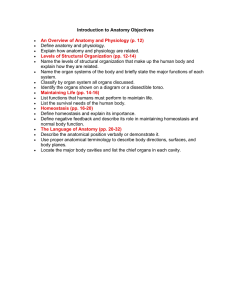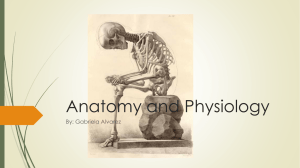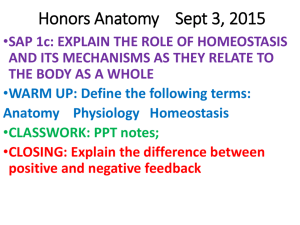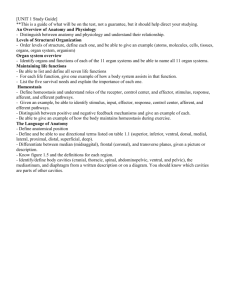An Introduction to Anatomy and Physiology
advertisement
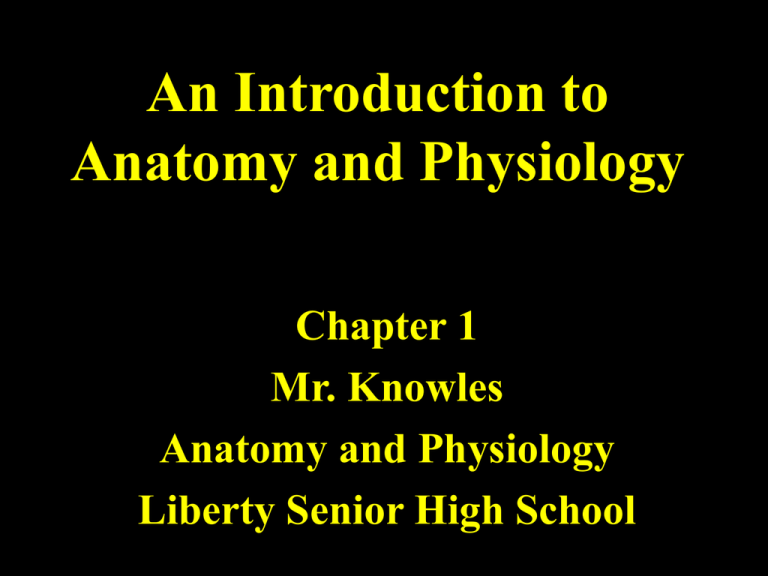
An Introduction to Anatomy and Physiology Chapter 1 Mr. Knowles Anatomy and Physiology Liberty Senior High School A Brief Outline I. The Sciences of Anatomy and Physiology A. Definitions B. Relationship II. Common Themes in Anat. and Phys. A. Structure and Function B. Levels of Organization C. Homeostasis and System Regulation What is Anatomy and Physiology? • Anatomy “to cut open”- the study of internal and external structures. Examples are gross and microscopic anatomy. • Physiology Study of how anatomical structures perform vital functions. Examples are physiologists and therapists. Two Perspectives • The Anatomiststudies a truck by measuring, photographing, and taking apart its various parts. Two Perspectives • The Physiologistwould study the truck by driving it, testing the brakes to determine how they work, and figure out how the engine performs. Early Anatomists • Hippocrates- Greek philosopher and physician, 400 B.C. • Hippocratic Oath • Four “Humours” of the body. • Observations, little Experimentation Greek and Roman Surgical Instruments Early Black Bag Claudius Galenus (Galen) • Roman anatomist during the 1st Century. • Described the human anatomy in detail. • Little understanding of physiology. Galen’s Office Galen’s Specimens Vesalius • 16th Century anatomist who provided exquisite detail of systems. • Experimentation with domestic animals. To determine function. • Assumed Galen to be correct; not questioned. Vesalius at Work! William Harvey • 17th Century English anatomist who questioned some of Galen’s conclusions. • Determined how the CV system worked in 1628 publication. • Used experimentation to prove CV function. 1st Theme: Structure and Function are Related Structure Function Form and Function are Related • Example: the human elbow joint- ulna (forearm) and the humerus bone of upper arm form a hinge joint. • Both at macroscopic and microscopic levels. • • • • • 2nd Theme: Levels of Organization Atoms/chemicals form the Molecular Level. Organelles organized into the Cellular Level. Cells are organized into a Tissue Level. Several tissues form the Organ Level. Several organs form the Organ System Level. • Organ systems function together for the Organism Levels of Organization • Functional and structural relationship between the levels. • Example: The Cardiovascular System. What functional characteristics must all organisms do in order to live? There are 8 functions. Design a creature! 1. Maintain Boundaries • Organisms must maintain boundaries to separate internal and external environments. • Protection from pathogens, dessication (loss of water), harmful chemicals. • Regulation. 2. Movement • Includes moving the body through the external environment and materials through the internal environment. • Even at the cellular level. • Muscular and skeletal. 3. Responsiveness • Sense changes in the environment (stimuli) and react to them. • Nervous, muscular, and skeletal 4. Digestion • Breaking down ingested foods into molecules the body can use for growth and maintenance. • Digestive, cardiovascular, endocrine. 5. Metabolism • Breaking down complex molecules simple ones for building blocks. • Making simple ones complex ones. • Simple Molecules Energy • Several systems. 6. Excretion • Removing toxic solid, liquid, and gases. • Examples are indigestible solids, urea, and CO2. • Digestive, urinary, and respiratory systems. 7. Reproduction • Occurs at the cellular and organismal levels. • Includes the reproductive, endocrine, nervous, and muscular. 8. Growth • Increase in size of body or tissue. • Increase in the number of cells in all systems. Some Organ Systems • • • • • • • Nervous Cardiovascular Respiratory Integumentary Endocrine Muscle Skeletal • • • • • • • Processing center Internal transport Gas exchange Protection, regul. Communication Movement Support How are Organ Systems Related? Processing Centers CV System Respiratory System Integumentary System Interrelated Systems Link to the Homeostasis Lecture Homeostatic Regulation • Homeostasis- The existence of a stable internal environment. • Has 3 Parts: Receptor: a sensor that is sensitive to a particular environmental change or stimulus. Control Center: receives and processes the information supplied by the receptor. Effector: a cell or organ that responds to the commands of the control center and whose activity opposes or enhances the original stimulus. Homeostasis in Your House! Show Me Some Homeostasis! Two Types of Homeostasis • Negative Feedback: • Positive Feedback: when the effector(s) initial stimulus activated by the produces a response control center that exaggerates or oppose or eliminate enhances its effects. stimulus. • Labor Contractions • Many examples; most common • Blood Clotting feedback system. Physiological Example Show me an example of homeostasis! The New Living BodyHomeostasis, 1995, VT 574.1 HOM

